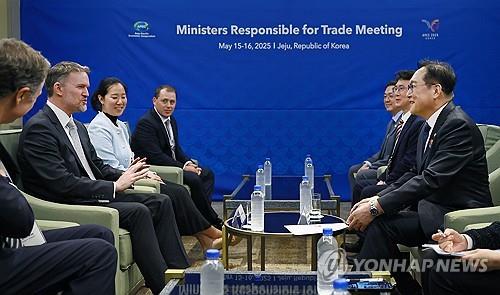- California Assembly OKs highest minimum wage in nation
- S. Korea unveils first graphic cigarette warnings
- US joins with South Korea, Japan in bid to deter North Korea
- LPGA golfer Chun In-gee finally back in action
- S. Korea won’t be top seed in final World Cup qualification round
- US men’s soccer misses 2nd straight Olympics
- US back on track in qualifying with 4-0 win over Guatemala
- High-intensity workout injuries spawn cottage industry
- CDC expands range of Zika mosquitoes into parts of Northeast
- Who knew? ‘The Walking Dead’ is helping families connect
S. Korea’s exports to U.S., China likely to decline further over U.S. tariff scheme: trade chief
South Korea’s exports to the United States and China are expected to decline further in May, as the impact of the Donald Trump administration’s sweeping tariff scheme has begun to materialize, the country’s top trade official said Wednesday.
Trade Minister Cheong In-kyo made the assessment after government data showed that exports declined 2.4 percent in the first 20 days of May compared to a year earlier, due to a drop in shipments to the U.S. amid ongoing tariff measures.
During the first four months of 2025, cumulative exports totaled $217.9 billion, representing a 0.7 percent decrease compared to the same period last year, according to data from the Ministry of Trade, Industry and Energy.
Shipments to the U.S. and China went down 3.3 percent and 4.1 percent, respectively, while exports to ASEAN and the European Union rose 5.9 percent and 2.1 percent, respectively.
“In May, the impact of the U.S. tariff measures is expected to be fully reflected, leading to a decline in exports to the U.S. and China,” Cheong said during a meeting with officials overseeing export-related issues.
“We will maintain an emergency response system in cooperation with relevant agencies and continue to provide tailored support to address export challenges in each region,” he added.
The government has pledged to swiftly execute the funds allocated through the supplementary budget, including 84.7 billion won for the exporter voucher program and 150 billion won for small and mid-sized exporters through trade insurance.
“Technical consultations with the U.S. on the tariff policy are under way, and we will actively engage in discussions to find mutually beneficial solutions, while prioritizing our national interest,” Cheong said.
South Korea and the United States began a second round of working-level discussions in Washington on Tuesday (U.S. time), as Seoul has sought a complete exemption from the tariff scheme.
Last month, the U.S. began imposing reciprocal tariffs on partner nations, including 25 percent duties on South Korea, only to pause them shortly afterward to allow for one-on-one negotiations.
Seoul and Washington subsequently agreed to work toward a “package” deal on trade and other related issues before July 8, when Trump’s 90-day pause on reciprocal tariffs is to expire.













